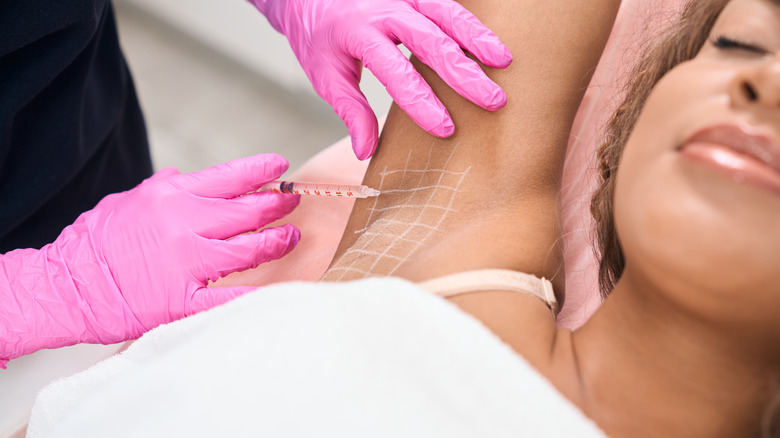Neurotoxins Are The New Deodorant. Here's How They Work
The term "neurotoxin" can sound incredibly intimidating to those who are unaware of its purpose. It may come as a surprise to learn that many of your favorite celebrities and influencers regularly pay to have neurotoxins injected into their skin. Before you flip out and scour the internet in search of answers, you should know that neurotoxins are, in fact, considered harmless. Neurotoxins are injectable solutions that are sold under a brand that you're likely already familiar with: Botox.
Botox, or Botulin toxin type A, is actually an injectable neurotoxin that has become so popular that the brand is now well-established in the everyday American's vocabulary. Other popular brands of neurotoxins include Dysport, Xeomin, and Jeuveau. The popularity of these neurotoxin injections has risen dramatically since Botox received U.S. Food & Drug Administration (FDA) approval for cosmetic use in 2002, per Botox Cosmetic. While neurotoxins are typically associated with cosmetic benefits, such as reducing wrinkles, they are also used to treat certain health conditions. For instance, if you are someone who experiences chronic or excessive sweating — medically known as hyperhidrosis — then neurotoxins may just be the solution you have been looking for. Here's everything you need to know about neurotoxin injections and how they can replace your antiperspirant collection.
The power of neurotoxins
Cosmetic neurotoxins, such as botulinum, are actually purified proteins that are designed to interrupt nerve signals to the muscles in your face (via Summit Health). By blocking these nerve signals from reaching the receptors, the target muscles in your face relax instead of contracting. This reduces wrinkles and fine lines caused by repetitive facial expressions. Furthermore, it prevents future wrinkles from forming.
You can receive neurotoxin injections in the forehead, lip area, cheeks, and eye area via a medical-grade needle. Typically, the procedure only lasts minutes and a topical anesthetic is not required, as the needle is quite small. However, you may request topical numbing or use an ice pack prior to your appointment. You can also receive neurotoxin injections in other areas of the body, such as your underarms, feet, hands, scalp, groin, and other small areas. This is great news for those with hyperhidrosis, as these are the main problem areas where you may notice severe sweating.
Neurotoxins and sweating
If you have hyperhidrosis, then you've most likely tried every antiperspirant and deodorant on the shelf — maybe you've even used both together. Dealing with major sweating can be inconvenient and embarrassing, and this condition often leads to social anxiety. Additionally, it can make you vulnerable to bacterial or fungal skin infections. Thankfully, Botox has been proven to reduce symptoms of hyperhidrosis by blocking the chemical signals that stimulate sweat production in your sweat glands, according to the International Hyperhidrosis Society. Botox injections can reduce extreme sweating by up to 87%. Results can last up to 12 months with some individuals reporting up to 14 months of dryness. After the initial treatment, follow-up injections are required for maintenance.
For those who experience extreme sweating, neurotoxin injections provide life-changing results that are safe, non-invasive, and relatively long-lasting. If you are interested in using neurotoxin treatments to relieve your symptoms — and you are not pregnant, breastfeeding, or have a serious medical condition that may interact with injections — speak to a dermatologist or general practitioner to discuss your options.


